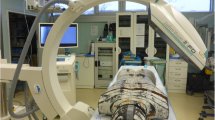Abstract
Purpose
To measure the radiation exposure at the knee and surrounding area during the use of 3D fluoroscopy.
Methods
An experimental study was conducted by using a human cadaveric knee as a focus point for the 3D fluoroscope. An isocentric C-arm fluoroscope machine was applied on the lateral side of the knee. The radiation dosage at the focus point and surrounding area was measured. The mean radiation exposure in each location was compared between low- and high-resolution scanning.
Results
The mean radiation sustained at the focus point was 44.0 ± 5.6 μSv and 20.0 ± 1.0 μSv in high- and low-resolution scanning, respectively. Radiation exposure on the opposite side of the C-arm machine was found to be higher than that on the other locations with the same distance from the focus point. In low-resolution scanning, radiation could not be detected beyond 75 cm from the focus point at the proximal, distal and same side of the machine. Radiation could be measured at a distance of up to 1.25 m on the opposite side of the machine. In high-resolution scanning, radiation could be measured at a distance of up to 1 m at the proximal, distal and same side of the C-arm, but up to 1.5 m on the opposite side.
Conclusion
Radiation exposure during 3D fluoroscopy of the knee decreases with increasing distance from the focus point. A higher number of scans in the high-resolution mode causes greater radiation exposure. In isocentric 3D fluoroscopy of the knee, a safe zone is located at least 1.5 m away from the focus point.




Similar content being viewed by others
References
Atesok K, Finkelstein J, Khoury A, Peyser A, Weil Y, Liebergall M, et al. The use of intraoperative three-dimensional imaging (ISO-C-3D) in fixation of intraarticular fractures. Injury. 2007;38:1163–9.
Kendoff D, Gardner MJ, Citak M, Kfuri M Jr, Thumes B, Krettek C, et al. Value of 3D fluoroscopic imaging of acetabular fractures comparison to 2D fluoroscopy and CT imaging. Arch Orthop Trauma Surg. 2008;128:599–605.
Rübberdt A, Feil R, Stengel D, Spranger N, Mutze S, Wich M, et al. The clinical use of the ISO-C(3D) imaging system in calcaneus fracture surgery. Unfallchirurg. 2006;109:112–8.
Citak M, Kendoff D, Kfuri M Jr, Pearle A, Krettek C, Hüfner T. Accuracy analysis of Iso-C3D versus fluoroscopy-based navigated retrograde drilling of osteochondral lesions: a pilot study. J Bone Joint Surg Br. 2007;89(3):323–6.
Richter M, Geerling J, Zech S, Goesling T, Krettek C. Intraoperative three-dimensional imaging with a motorized mobile C-arm (SIREMOBIL ISO-C-3D) in foot and ankle trauma care: a preliminary report. J Orthop Trauma. 2005;19:259–66.
Holly LT, Foley KT. Percutaneous placement of posterior cervical screws using three-dimensional fluoroscopy. Spine. 2006;31:536–40.
Summers LE, Kouri JG, Yang M, Patrick Jacob R. Odontoid screw placement using isocentric 3-dimensional C-arm fluoroscopy. J Spinal Disord Tech. 2008;21:45–8.
Patel VV, Dwyer A, Estes S, Burger E. Intraoperative 3-dimensional reconstructed multiplanar fluoroscopic imaging for immediate evaluation of spinal decompression. J Spinal Disord Tech. 2008;21:209–12.
Giachino AA, Cheng M. Irradiation of the surgeon during pinning of femoral fractures. J Bone Joint Surg Br. 1980;62-B(2):227–9.
Riley SA. Radiation exposure from fluoroscopy during orthopedic surgical procedures. Clin Orthop Relat Res. 1989;248:257–60.
Mehlman CT, DiPasquale TG. Radiation exposure to the orthopaedic surgical team during fluoroscopy: “how far away is far enough?”. J Orthop Trauma. 1997;11:392–8.
Miller ME, Davis ML, MacClean CR, Davis JG, Smith BL, Humphries JR. Radiation exposure and associated risks to operating-room personnel during use of fluoroscopic guidance for selected orthopaedic surgical procedures. J Bone Joint Surg Am. 1983;65(1):1–4.
Theocharopoulos N, Perisinakis K, Damilakis J, Papadokostakis G, Hadjipavlou A, Gourtsoyiannis N. Occupational exposure from common fluoroscopic projections used in orthopaedic surgery. J Bone Joint Surg Am. 2003;89-A(9):1698–703.
International Commission on Radiological Protection (ICRP). The 2007 recommendations of the International Commission on Radiological Protection. ICRP publication 103. Ann ICRP. 2007;37(2-4):81–100.
Acknowledgments
This study was supported by the Siriraj Research Development Fund.
Conflict of interest
None.
Author information
Authors and Affiliations
Corresponding author
Rights and permissions
About this article
Cite this article
Tharmviboonsri, T., Riansuwan, K., Nitising, A. et al. Radiation exposure during 3D fluoroscopy of the knee: an experimental study. Eur J Trauma Emerg Surg 38, 307–311 (2012). https://doi.org/10.1007/s00068-011-0165-7
Received:
Accepted:
Published:
Issue Date:
DOI: https://doi.org/10.1007/s00068-011-0165-7




